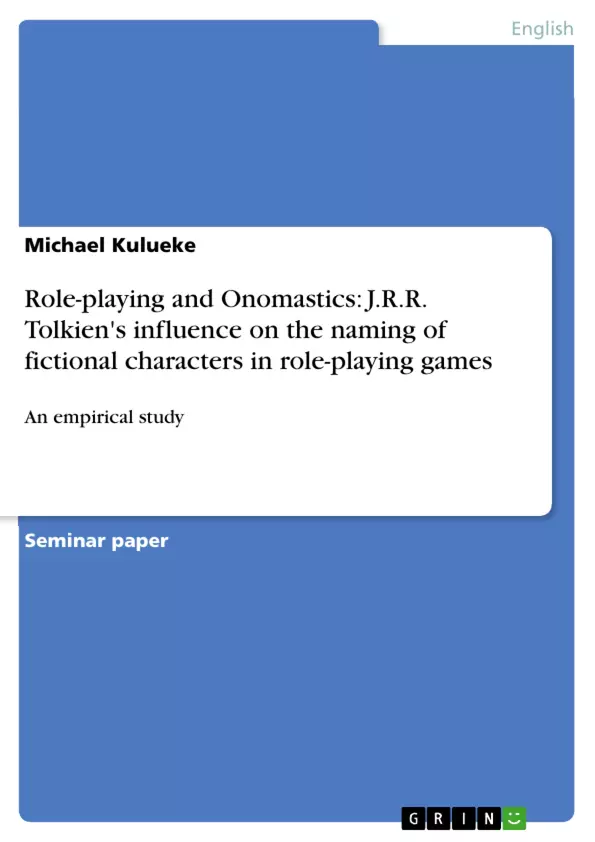Fantasy-role-playing games resemble a part of culture dedicated to the play and shortwhile identification with fictional characters. First appearing in the 1960s, role-playing games secured a small spot in a society crowded by fans of Fantasy-, SciFi- or other fictional literature. One of the major works of fantasy-literature is 'The Lord Of The Rings', 'The Hobbit' or 'The Silmarillion' of John Ronald Reuel Tolkien (1892-1973). Tolkien, as a philologist of early medieval languages, created not only a range of new (and adapted) races to people his universe of Middle Earth, he also created for each race a specific language, with own grammar, vocabulary and: names. He spent great afford in creating so distinct languages that no one could misunderstand the words of the Elves as words by Dwarves, for example.
This linguistic effort is supposed to play an important role in the reception of his works, and regarded to play a certain role in the influence Tolkien's works have today on other works of fantastic- and non-fantastic literature.
Role-playing games resemble a part of creative and active literature, where the players tell and create stories while imaginatively acting in these worlds. For taking part in such an interactive story, one has to create an alter ego, an avatar, or just: a character. These characters are the means by which players interact in the fictional worlds, and as they are most of the time a part of their self-expression and self-conception, they are every time a sum of all the influences on the players mind and knowledge about culture and all its aspects.
This paper will investigate on the influence of Tolkien's works on one particular part of role-playing games: the creation of names for those characters used to interact in fictional worlds.
The assumption is that, as Tolkien is commonly regarded as a significant influence on literature and fantasy in special, his impact on the naming of fictional characters must be somehow traceable.
Inhaltsverzeichnis (Table of Contents)
- Introduction
- Role-playing and Onomastics
- The survey
- The process of name-creation and its characteristics
- The evaluation of the collected names
- Distribution of letters
- Comparison of name-structure
- Conclusion
Zielsetzung und Themenschwerpunkte (Objectives and Key Themes)
This paper investigates the influence of Tolkien's works on the creation of character names in role-playing games. It aims to explore whether Tolkien's impact on fantasy literature is reflected in the naming practices of players. Key themes:- The role of names in character creation and role-playing
- Tolkien's influence on fantasy literature and gaming
- The process of name-creation in role-playing games
- The analysis of collected character names
- The significance of onomastics in role-playing games
Zusammenfassung der Kapitel (Chapter Summaries)
- Introduction: This chapter introduces the topic by exploring the significance of role-playing games and the influence of Tolkien's works on fantasy literature. It highlights the importance of names in creating characters and their impact on the player's experience.
- Role-playing and Onomastics: This chapter delves into the definition of role-playing games and the importance of character creation in the overall process. It emphasizes the crucial role of names in establishing a character's identity and connecting them to the game world.
- The survey: This chapter explains the methodology of the survey conducted to gather data about the influences on character naming in role-playing games. It outlines the specific questions asked and the expected outcomes from the survey.
- The process of name-creation and its characteristics: This chapter analyzes the process of name creation, exploring the factors that influence players' choices and the characteristics of names commonly used in role-playing games.
- The evaluation of the collected names: This chapter presents the analysis of the collected names, focusing on the distribution of letters and the comparison of name structures. It examines the trends and patterns observed in the collected data.
Schlüsselwörter (Keywords)
This paper focuses on the intersection of onomastics, role-playing games, and Tolkien's influence on fantasy literature. Key concepts include character creation, name-creation, fantasy worlds, and the analysis of collected character names from role-playing games.- Quote paper
- Michael Kulueke (Author), 2011, Role-playing and Onomastics: J.R.R. Tolkien's influence on the naming of fictional characters in role-playing games, Munich, GRIN Verlag, https://www.grin.com/document/211146



